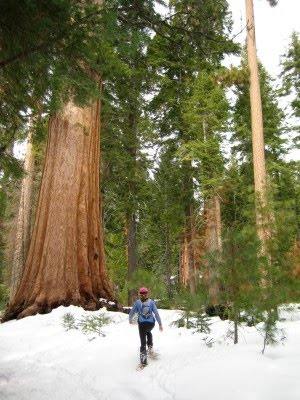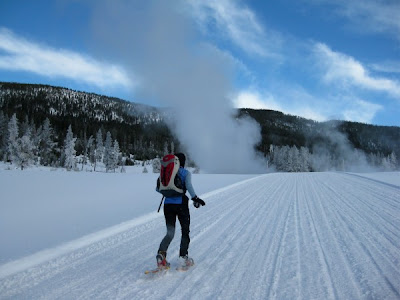 Last winter, we published a post entitled Snowshoe Running – Fun or Flop? Well, based on the amount of interest the post has generated and our own recent experience, we’d say that snowshoe running is fun! With that in mind, we approached Adam Chase, the long-time captain of the Atlas [Snowshoe] Racing Team, in hopes that he would share his vast knowledge on snowshoe running. Fortunately, Adam agreed to explain why runners might want to snowshoe, including its cross training benefits, as well as the basic equipment best suited for snowshoe running and snowshoeing safety.
Last winter, we published a post entitled Snowshoe Running – Fun or Flop? Well, based on the amount of interest the post has generated and our own recent experience, we’d say that snowshoe running is fun! With that in mind, we approached Adam Chase, the long-time captain of the Atlas [Snowshoe] Racing Team, in hopes that he would share his vast knowledge on snowshoe running. Fortunately, Adam agreed to explain why runners might want to snowshoe, including its cross training benefits, as well as the basic equipment best suited for snowshoe running and snowshoeing safety.
Why Snowshoe?
By Adam W. Chase
For athletes and recreational types who live in colder climates where running outside is not always a year-round option, snowshoeing represents a low-impact alternative to dealing with icy roads. For those averse to jeopardizing their conditioning from the fall training or racing season, snowshoeing and its many benefits is an attractive alternative to indoor tracks, treadmills, exercise cycles, rowing machines, Stairmasters, aerobics classes, and other indoor activities that quickly grow as stale as processed air.
For some multi-sport athletes, snowshoeing is not just for cross training anymore. Beginning in November and ending in April, there are snowshoe races scheduled across the country almost every weekend. The race offerings include snowshoe “track and field” events, 5Ks, winter triathlons (ski, bike, snowshoe), quadrathlons (bike, run, ski, snowshoe), and ultra-distance races. The number of participants in these competitions has grown by leaps and bounds and the fields are now packed with high-caliber multi-sport athletes who enjoy the variety of benefits that the sport offers.
Snowshoeing uphill through heavy powder, especially at altitude, will drain your system and stress your cardiovascular system more than almost any other type of workout. Best of all, it does so with almost no jarring of your bones. Snowshoeing is a wonderful way to build strength and fitness without straining those joints that are often battered during long road runs. It is also a terrific way to get away from the crowds and into the quiet of winter’s backcountry, where you can set your own tracks and see some wildlife.
As a competitive snowshoe racer, trail runner, ultramarathoner, and adventure racer who loves to run outside year round, I appreciate the opportunity that snowshoes afford me by opening up otherwise impassable winter Rocky Mountain trails. For me, the snowshoe racing season is something that I look forward to in and of itself, although it is also the perfect complement to my other athletic pursuits. While others either take the winter off or restrict their training and racing to gyms, pools, and indoor tracks after the snow has fallen, I welcome the snow like a child who can’t wait to go sledding.
Cross-Training Benefits
Distance runners and other endurance athletes may want to combine snowshoeing, trail and road running (when possible) and indoor track workouts to keep themselves fast and fit during the winter. If managed well, your snowshoe season should dovetail with your road and trail racing seasons because the strength and endurance gains of snowshoeing will complement running. Snowshoeing will help you as you enter your early spring season, just as the endurance base from your fall season will be a terrific asset when you head into the early snowshoe races.
As a runner or multi-sport athlete, if you are just introducing yourself to snowshoeing, be aware that you will be taxing different muscles and are likely to experience significant soreness during or after your maiden jaunt. Resistance training in the pre-season and stretching before and after snowshoeing will help to reduce that pain. Snowshoeing is a great source of strength training, particularly for your legs. Depending upon the terrain and snow conditions, you will work your hip flexors, quadriceps, gluteus maximus, gastrocnemius, abductors, adductors, and hamstrings. Snowshoeing also requires upper body strength for powering through powder, pumping up hills, and balancing on uneven snow.
Danelle Ballengee, author of “High Performance Snowshoeing” and once the nation’s top-rated female snowshoer, suggests a lower body weight-training workout that includes leg extensions, lunges, squats, leg press, leg curls, kick backs, abduction and adduction cable work, seated and standing calf raises, and leg raises. Ballengee, who has a degree in kinesiology, credits snowshoeing with such physiological benefits as increasing cardiac output, lowering your resting heart rate, increasing muscle mass, strength, and endurance, strengthening joints and tendons, increasing flexibility, and enhancing muscular balance.
If you are going to be snowshoeing at altitude, you should try to prepare for the season by maintaining a good endurance base. Do some trail runs or mountain bike rides in the high country in the late fall before the snow starts to fly. As with most winter sports, warming up be
fore you begin to exert yourself is crucial to your performance. According to Tom Sobal, the most victorious competitor in the sport of snowshoeing, failure to warm up properly is likely to result in injury, sub-maximal performance, and less enjoyment, whether you are training or racing. Sobal recommends starting out with an easy, slow pace that gradually increases to slightly faster than your anticipated pace. This should last between seven and fifteen minutes. After a couple short surges at an even faster pace, you should slow back down and quickly remove any excess clothing, adjust your equipment, and recover just before the start of your training or race.
Equipment
Snowshoe runners often end up with wet butts as the result of snow flipped up by their own snowshoes. Given that, I recommend water-resistant pants, such as those made of a microfiber material and that you close all of your pockets so that they do not fill up with flying snow. For shorter, more intense workouts or races, simple Lycra tights will probably suffice, but have some other pants available so you can change out of your wet ones immediately. Wool socks and, if the snow is deep, gaiters to protect your ankles from intruding snow, are also recommended.
Unless you are hiking and not running on your snowshoes, running shoes are probably your best bet for footwear. Snow provides ample cushioning and the snowshoe will give you support and stability. If it is wet out, you should choose some shoes that waterproof-breathable membrane, such as GORE-TEX. Err on the side of a shoe that is a half-size large so that you can layer socks. Another tip is to select running shoes that have a rear lip on the outsole to prevent the snowshoe straps from slipping off.
Safety
Safety is vital when you out in the cold and unpredictable winter weather, especially when in the backcountry. It is important to carry a compass, map, sun protection, and a first aid kit. Avalanche danger is a very real concern, so know your snow, beware of depth hoar — a type of snow that that raises the likelihood of an avalanche — take an avalanche course, carry an avalanche beacon and shovel, and avoid steep slopes.
Be cognizant that you will be burning more calories and require more liquids in the cold and/or high altitude, so carry extra food and water. Keep your liquids close to your body to prevent freezing. If you use a hip-pack to hold your water bottle, remember to put the bottle in the holster upside down so the water will not freeze up and block the nozzle.
Other emergencies that you should try to prepare for include hypothermia and frostbite, altitude sickness, equipment failure, wildlife, and the dreaded drunken snowmobiler!





